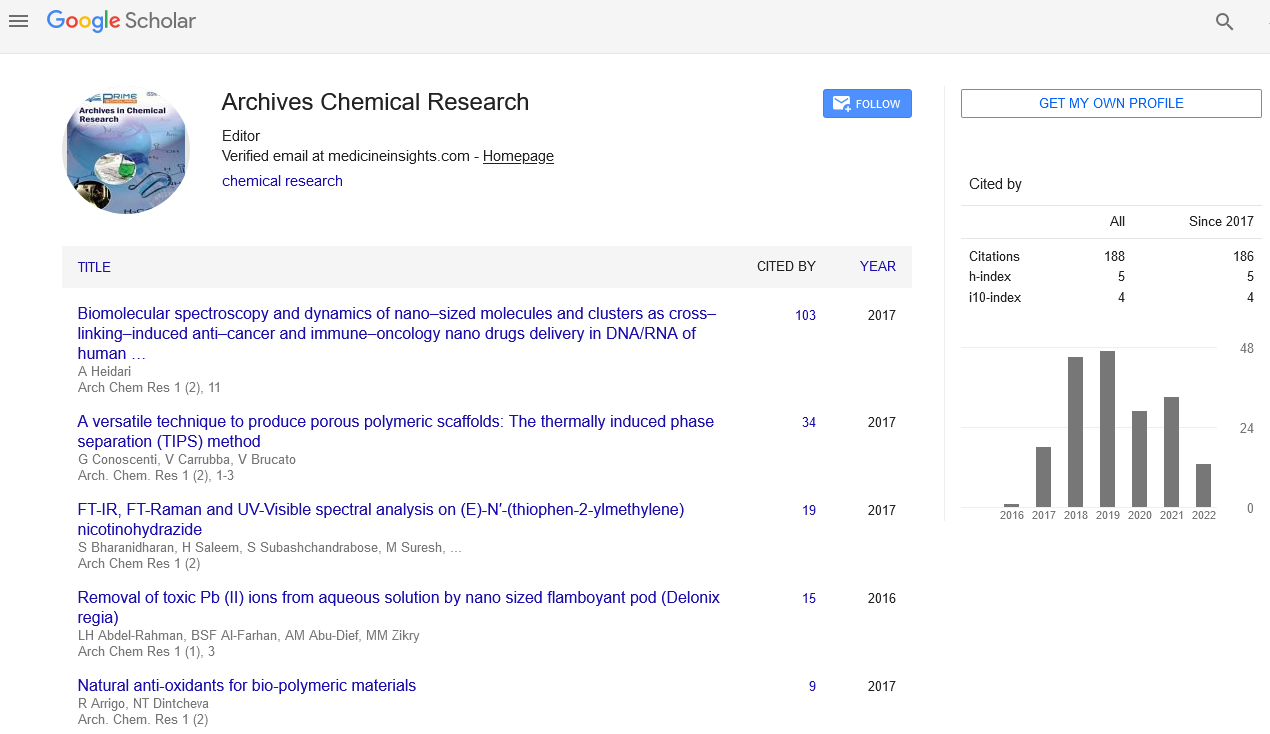Short Communication - (2023) Volume 7, Issue 4
Methyl Thiocyanate in Water: A Molecular Ballet in Aqueous Solution
Agnes Gabrielle*
Department of Chemical Science, Medical College of Drammen, Norway
*Correspondence:
Agnes Gabrielle,
Department of Chemical Science, Medical College of Drammen,
Norway,
Email:
Received: 29-Nov-2023, Manuscript No. IPACRH-24-18743;
Editor assigned: 01-Dec-2023, Pre QC No. IPACRH-24-18743 (PQ);
Reviewed: 15-Dec-2023, QC No. IPACRH-24-18743;
Revised: 20-Dec-2023, Manuscript No. IPACRH-24-18743 (R);
Published:
27-Dec-2023, DOI: 10.21767/2572-4657.7.4.40
Introduction
In the aqueous realm of chemistry, the presence of methyl
thiocyanate introduces a captivating dance of molecules,
where the interplay of water and this organic compound
unfolds with intricate precision. This article delves into the
dynamics of methyl thiocyanate in water, exploring its solubility,
interactions, and the implications for both environmental
and biochemical contexts. Methyl thiocyanate, a compound
featuring a methyl group attached to a thiocyanate moiety
(N=C=S), engages in a delicate ballet upon entering water.
The solubility of this organic compound in water is influenced
by a complex interplay of molecular forces. The polar nature
of water molecules and the presence of functional groups in
methyl thiocyanate dictate the extent to which the compound
can dissolve in aqueous solution.
Description
As a polar solvent, water interacts favorably with polar and ionic
compounds, facilitating their dissolution. Methyl thiocyanate,
with its polar thiocyanate group, experiences solvation in water
through hydrogen bonding and dipole-dipole interactions.
However, the nonpolar methyl group introduces a nuanced
balance, influencing the overall solubility of the compound. This
delicate equilibrium between polar and nonpolar interactions
shapes the solubility dynamics of methyl thiocyanate in water.
Within the aqueous solution, the hydrogen bond takes center
stage in the molecular tango between water and methyl
thiocyanate. Water molecules, with their polar nature, engage
in hydrogen bonding with the electronegative atoms of the
thiocyanate group. This dance of hydrogen bonds stabilizes
the solvated methyl thiocyanate molecules, influencing their
arrangement and behavior in the aqueous environment.
The hydrogen bond interactions not only affect the solubility
but also influence the molecular conformation of methyl
thiocyanate in water. The geometry of hydrogen bonds can lead
to specific orientations and alignments of molecules, adding an
additional layer of complexity to the dance of molecules in the
solution. Understanding the behavior of methyl thiocyanate
in water is crucial for assessing its environmental impact.
Methyl thiocyanate can be introduced into water systems
through industrial processes, agricultural runoff, or natural
sources. Its solubility and interactions in water govern its
fate, transport, and potential effects on aquatic ecosystems.
In aqueous environments, methyl thiocyanate may undergo
transformations influenced by factors such as pH, temperature,
and the presence of other chemicals. The solvation dynamics
in water play a role in determining the availability of methyl
thiocyanate for various chemical reactions or interactions with
other water constituents. Beyond its presence in environmental
waters, the interactions of methyl thiocyanate in aqueous
solutions bear relevance to biochemical systems. Methyl
thiocyanate is implicated in certain metabolic pathways and can
be produced endogenously in the human body. Understanding
its behavior in water is essential for unraveling its role in
biological processes and potential health implications.
Conclusion
In the aqueous ballet of molecules, methyl thiocyanate takes
center stage, engaging in a dance of solubility, hydrogen
bonding, and dynamic interactions. The interplay between
water and this organic compound unfolds with implications for
both environmental processes and biochemical pathways. As
researchers continue to unravel the molecular choreography
in aqueous solutions, the dance of methyl thiocyanate offers
insights into the intricate world of solvation and molecular
behavior within the aqueous realm.
Acknowledgement
None.
Conflict Of Interest
Authors declare no conflict of interest.
References
- Acharyya J (2009) FDI, Growth and the environment: Evidence from India on CO2 emission during the last two decades. J. Econ Dev. 34(1): 43.
[Crossref] [Google Scholar]
- Blottnitz V, Curran V, Blottnitz H, Curran M (2007) A review of assessments conducted on bio-ethanol as a transportation fuel from a net energy, greenhouse gas and environmental life cycle perspective. J. Clean Prod. 15(7): 607-619.
[Crossref] [Google Scholar]
- Smith J, Durucan S, Korre A, Shi Q (2011) Carbon dioxide storage risk assessment: Analysis of caprock fracture network connectivity. Int J Greenhouse G Con. 5 (2): 226-240.
[Crossref] [Google Scholar]
- Olabode A, Radonjic M (2013) Experimental investigations of caprock integrity in CO2 sequestration. Energy Procedia. 37 (1): 5014-5025.
[Crossref] [Google Scholar]
Citation: Gabrielle A (2023) Methyl Thiocyanate in Water: A Molecular Ballet in Aqueous Solution. Arch Chem Res. 7:40.
Copyright: © 2023 Gabrielle A. This is an open-access article distributed under the terms of the Creative Commons Attribution License, which permits unrestricted use, distribution, and reproduction in any medium, provided the original author and source are credited.

